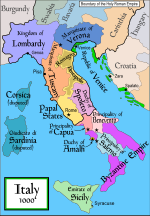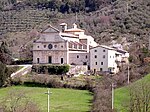San Paolo inter vineas, Spoleto

San Paolo inter vineas is a Romanesque-style, Roman Catholic church in Spoleto, region of Umbria, Italy. The term inter vineas refers to its location outside town, among the vineyards. A church at the site was founded in the 6th century in time of Pope Gregory the Great, when legend holds that a miracle occurred when a heretical Arian Lombard bishop was struck blind while holding mass. The first document date buildings here by the 10th century, when the church was affiliated with a Benedictine order convent of nuns. The church was rebuilt in 1234, and consecrated by Pope Gregory IX. In the 14th century, the monastery was abandoned and relocated inside the city walls, next to the church of Sant'Agata. In 1771, the church was again reconstructed and the interior redone. In 1965, the reconstruction attempted to highlight original late-Romanesque style of the early 13th century. The facade recalls two other churches in Spoleto, San Pietro and San Ponziano, with a central rose window and a suggestion of the central nave and two aisles. The interior has frescoes from the 13th century.
Excerpt from the Wikipedia article San Paolo inter vineas, Spoleto (License: CC BY-SA 3.0, Authors, Images).San Paolo inter vineas, Spoleto
Via San Paolo,
Geographical coordinates (GPS) Address External links Nearby Places Show on map
Geographical coordinates (GPS)
| Latitude | Longitude |
|---|---|
| N 42.7297 ° | E 12.73 ° |
Address
San Paolo "inter vineas"
Via San Paolo
06049
Umbria, Italy
Open on Google Maps











